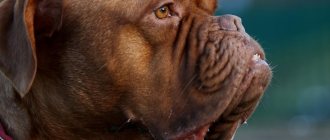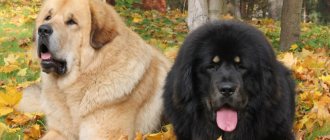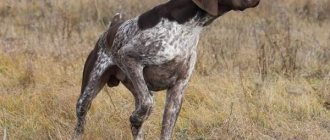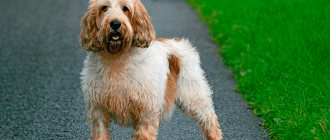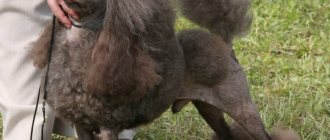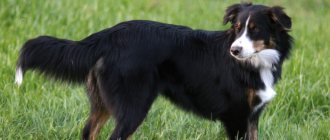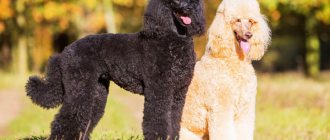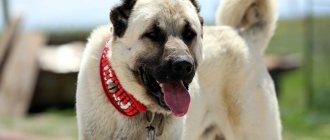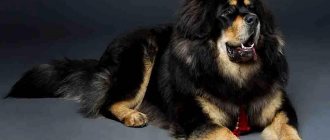Description of the Dogo Argentino breed
Popularity 150th place among 263 dog breeds
Lifespan:
12-16 years old
Breed group:
Withdrawn
Height:
males: 60-68 cm, females: 60-65 cm
Country of origin:
Argentina
Average price:
30-35 thousand rubles
Weight:
males: 40-45 kg, females: 40-43 kg
Latest articles Cat health
Ataxia in cats: what it is, how it manifests itself and is treated 01/23/2022 173 0 0
Cat health
Leukemia, or viral leukemia in cats 01/23/2022 152 0 0
Key facts
The breed was created as a pack hound for baiting large animals.
Despite their large size and ferocious appearance, the dogs are non-aggressive and affectionate. Inexperienced dog owners run the risk of not being able to handle the Dogo Argentino due to its independent nature.
In addition to hunting, guarding and guarding characteristics of the Dogo Argentino are well developed.
They get along with children, but it is better not to leave it unattended with kids due to its size. There is no point in trying to arrange for him to live together with cats and rodents.
Dogs are simple and undemanding to care for, but at the same time they look impressive. The description of the Dogo Argentino breed includes only one standard color - pure white.
The Dogo Argentino's lifespan and its health depend entirely on the care and attention of its owners. Under favorable conditions, dogs live at least 13-14 years.
Breed traits
Breed traits (on a 5-point scale)
| Dogo Argentino | |||
| Activity | in the house | 2.9 | |
| on the street | 3.5 | ||
| Obedience | training | 2.9 | |
| strangers | 1 | ||
| Domination | in family | 3.7 | |
| over dogs | 4.2 | ||
| Defending your territory | from people | 3.5 | |
| from dogs | 3.6 | ||
| Sociability | in family | 2.9 | |
| with strangers | 1 | ||
| with dogs | 1.3 | ||
| Concentration | in family | 4 | |
| in front of strangers | 3.7 | ||
| with dogs | 3.6 | ||
| Aggressiveness | in family | 3 | |
| to strangers | 5 | ||
| to the dogs | 5 | ||
| to cats | 3 | ||
| Family behavior | calmness | 2.7 | |
| demand for affection | 2 | ||
| excitability | 3.2 | ||
| playfulness | 1.3 | ||
| excessive barking | 1.4 | ||
| behavioral breakdowns | 2.2 | ||
| Tolerance for children | up to 4 years | 1.2 | |
| over 4 years old | 1.3 | ||
| Institutional use | watchman | 3.9 | |
| bodyguard | 4.4 | ||
This breed is often compared to the following dog breeds: Cane Corso, American Staffordshire Terrier, Rottweiler, Doberman Pinscher, Bull Terrier.
The photo shows what a Dogo Argentino looks like:
History of the origin of the Dogo Argentino
The Dogo Argentino as a separate breed arose in the 20th century, but the history of the origin of the breed began much earlier. The ancestor of the Argentinean was the ferocious Cordoba fighting dogs crossed with Alans. This had to be done because the breed was so bloodthirsty that it was not even possible to breed them with each other.
Cordoba dogs were regular participants in the dog pits, fighting to the last. In the process of foreign trade with Argentina, various fighting breeds arrived from Europe, including cord dogs. In their homeland, aggressive animals were not welcome and over time degenerated, but they gave blood for the development of a new breed.
The Martinez brothers, landowners and keen hunters, used Cordoba dogs for baiting, but due to the aggressive nature and pugnacity of the animals, the brothers could only bait two animals. Although the dogs were suitable for hunting, they could not work in a pack. Young people wanted to improve the breed and rid it of unnecessary aggressiveness.
The brothers began their first experiments in breeding ideal dogs in 1925. The Martinezes wanted to combine the incompatible - a fighting appearance, a hunting instinct and a calm, friendly disposition that would make the animals suitable for pack hunting.
For mating, Cordovan females were purchased, which were slightly less wild than males. They became the basis for the breeding of the Argentines. Dogs that had the desired advantages were crossed with them: scent, size, speed. Great Danes, Dogues de Bordeaux, Irish Wolfhounds, Pyrenean Mountain Dogs, and Pointers were involved in breeding the breed.
The first standard of the breed appeared before its creation, the way one of the brothers wanted it to be, and then the dogs were adjusted to this image. Their father also supported the brothers’ aspirations. He helped with the care and feeding of the animals. Many friends were interested in what would come of this, so they helped financially, hoping to get a puppy if the experiment was successful.
The breed was polished for 30 years, as a result of which two branches appeared - Araucana (a cross with Bordeaux) and Guarani (from matings with a wolfhound). Neither one nor the second breed has reached us, but the traces of both can be traced in the appearance of the modern Argentinean.
When Antonio's brother died while hunting, many breeders began to randomly breed dogs, spoiling the selection. Only the second brother, Augustine, managed to stop this.
The breed spread throughout the world thanks to the Austrian dog handler Otto Schimf. He fell in love with the Argentines and brought them to Europe, helping to spread the breed throughout the world. In 1973, the breed was recognized by the FCI, and nine years earlier it was registered by the Argentine Canine Federation.
Today the Argentinean is the only officially recognized canine representative of his country. The breeders managed to combine power, beauty, hunting qualities and courage with a good-natured, non-aggressive and playful character. However, Dogo Argentino is prohibited for breeding in a number of countries.
Kinds
This magnificent dog does not even have a standard color other than white, so there are no varieties. But there is one breed that not only contributed its genes and fighting qualities, but also pushed for the very creation of the Dogo Argentino. The Cordoba dog was very popular in dog fighting rings in the early 20th century.
She was called the "skinner." Having seen such a fighter at one of the bloody performances, the Martinez brothers decided to create a unique mixture, combining the best qualities of several representatives. And as a basis they took Cordovan females, not as bloodthirsty as males.
The Cordoba dog was also created in Argentina. Although its history begins much earlier, from the time of the conquistadors’ capture of the New World. Their irresistible desire to occupy new territories was supported by weapons and menacing, ferocious dogs.
They were specially trained to intimidate the local population so that they would not even think of attacking the invaders. From these animals the Cordovan dogs later came. Their main task, in addition to security, was dog fighting. And in the entire history of the breed, not one of its representatives has lost a single battle.
But the paradox is that despite clear leadership in this field, the breed gradually died out precisely because of its fighting character. The reason was the reluctance of the dogs to interbreed. Due to their bloodthirstiness, they tried to kill each other. Gradually, the breed dissolved, remaining as a memory only in the genes of the Dogo Argentino.
The Cordoba dog is the ancestor of the Dogo Argentino
Appearance of the Dogo Argentino
General impression
Dogo Argentinos are large, well-built animals with a proportional build and well-defined muscles. This indicates the dog’s excellent physical characteristics. In the photo, the Dogo Argentino seems formidable, but the muscular handsome man has a big and kind heart beating inside.
Head
A head with clearly visible muscles and no subcutaneous fat, with smooth lines. Well developed jaw muscles. The features of the skull are blurred. The muzzle is of excellent proportions, smoothly transitioning from the forehead to the nose, tapering slightly towards the end. A characteristic feature is a slightly elongated topline.
The black nose with wide nostrils is slightly turned up, causing the muzzle to bend slightly. The lips are short and also have black pigmentation. Ears may be cropped. They are spaced widely and set quite high. Cropped ears are triangular in shape and half the size of undocked ones.
Brown eyes are spaced apart and set deep. Black pigmentation of the eyelids is desirable. Argentines have a scissor bite, but a straight bite is allowed. The teeth in the jaw are large; lack of teeth according to the standard is a disadvantage.
Neck
The neck is thick, but taut, with a clear scruff and folds on the throat that do not turn into dewlap.
Torso
The body fits into a rectangle, the croup is wide, equal in width to the chest. The chest is powerful, the underline is taut. The muscular back ends with a strong croup.
Tail
The tail is long, saber-shaped, moderately wide. The angle between the tail and the body is 40 degrees. When moving, the dog carries it along the horizon or slightly higher, but does not throw it over its back or twist it.
Forelegs
The forelimbs are muscular and sinewy. The relief on the shoulders is clearly visible. The flattened pasterns are a continuation of the steep forearms, the paws are round with toes bunched together.
Hind limbs
The hindquarters provide the Argentine with good propulsion. They are slightly inclined and have a pronounced muscle relief. The thighs are slightly longer than the tibiae. The hocks are oval, the paw itself is smaller than the front one. There may be dewclaws, which are usually removed.
Movements
The movements are confident and very balanced. The step is measured, in the trot it is more sweeping. The Dogo Argentino has a distinctive gait. In a gallop you can appreciate all the power and admire the harmony of the animal.
Wool
The coat may or may not have undercoat. It depends on the climate in which the dog lives. The main coat is no longer than 2 cm.
Color
In the Dogo Argentino, the preferred colors are pure white, although the standard allows black pigmentation of the fur in the area of the ear or eye.
Dimensions
The height of Dogo Argentino males is 62-68 cm, females are slightly lower - 60-65 cm. A breed with these parameters is classified as large. Body weight depends on height and gender and averages 40-55 kg. The maximum weight of the Dogo Argentino is about 60 kg, but this is rare.
The size of the Dogo Argentino is quite large, but the dog in any case looks proportional.
Nutrition
For your dog to feel good and always full of energy, she needs proper nutrition. It is very important to maintain a balance of microelements and vitamins. This will guarantee good health and longevity. When a person takes a small pet, it is worth remembering that Dogo Argentino puppies have an excellent appetite.
But you should be careful and not give too much food to your small pet. To ensure that your dog is not obese and is full of strength and energy, you need to provide him with food in the amount of 7% of his total body weight during the day. It is best to divide food 4 times for puppies up to 6 months, and 2 times for dogs after six months.
Dogo Argentinos frolic on the street in summer
Since the Argentinean is a very active dog, meat must be present in its diet. It is preferable that it be raw. But if you use by-products such as liver, heart, lung and others instead of meat, then they need preliminary heat treatment.
It's best to boil them. In addition, the dog needs greens and various vegetables. In this case, it is better to exclude potatoes. It is better to replace it with various cereals. They contain much more useful substances and elements.
In addition, it will be useful for the dog to give fish, cottage cheese, preferably low-fat varieties, and other fermented milk products. It's best if it's kefir. Sweet, salty, smoked, bitter, fried, and flour foods are excluded from the Great Dane’s diet once and for all.
In order not to count the amount of microelements, nutrients and calories, it is best to give your dog special food. Manufacturers have already taken into account the necessary proportions.
Character of the Dogo Argentino
Despite the apparent ferocity, the character of the Dogo Argentino is very affectionate, kind, he adores his household. He is great with children; you only have to worry about violent games, in which the dog can knock down a child without calculating the force. Even puppies are distinguished by their remarkable strength.
But it is better not to keep other animals at home, since the hunting instinct in the Great Dane is highly developed. He will only get along with other medium and large dogs, and will tolerate the cat that was brought before him and with whom he grew up. The Argentinean is an excellent companion and devoted friend, a true canine aristocrat.
He needs his owner's attention and close physical contact. Dogo Argentinos love to be petted and petted. This big puppy will happily climb into his owner's lap.
Dogo Argentinos have an independent character. Who is this dog suitable for? He will be comfortable with people who love physical activity, as he is an energetic dog who needs regular exercise. With Dogo Argentina you will spend a lot of time outside.
It’s good if the owner is interested in developing the dog’s hunting or sports skills. If you like to sleep until lunch, are a homebody, or are not used to moving a lot, it is better to look for another, less energetic breed. Beginning dog breeders should not get an Argentine.
The Dogo Argentino is wary of strangers, but without aggression. At home they are excellent watchdogs. They prefer to scare trespassers and will only attack if there is a direct threat.
Great Danes often become bodyguard dogs. Strong devotion to the owner motivates the dog to protect his life even if the attacker is much larger than the dog himself. Moreover, the Argentine can easily emerge victorious from such a fight.
If you like to run outside in summer or winter, the Dogo Argentino will be an excellent running companion for you. The Argentine walks a lot and for a long time, so you should have enough free time. If you take him out a couple of times a day for 20 minutes, your pet will cause chaos in the apartment due to excess energy.
Levi Stars dog kennel. Spitz, Chihuahua, Dogo Argentino, Mastiff
https://dog-care.ru/porody/pitomniki/sobak-argentinskiy-dog-mastif-v-moskve.html
| Description: | Kennel RKF Chihuahuas and Pomeranians. From us you can purchase high-quality puppies from the best representatives of the breed, for exhibitions and breeding and as a pet. |
| Contacts: | 8-985-363-9824 and 8-987-813-9495 |
Education and training
Raising and training a Dogo Argentino is not difficult, as they are attentive animals. The dog is smart and savvy, loves interesting and non-standard exercises. An Argentinean must be socialized from childhood.
If you train yourself, you need to be a leader, which is not easy due to the dog’s too independent nature. Training should be regular and frequent so that the dog does not relax. Correctly performed exercise should be reinforced with a treat or toy. You cannot train a dog using beating - the dog will become upset and withdrawn, and training will not bring the desired result.
Looking for a Dogo Argentino? Find your pet from 1 offer As a gift
Dog kennel Fortuna Nix. Dogo Argentino, Mastiff
| Description: | Kennel Fortuna Nix, the oldest breeding kennel of Dogo Argentinos in Russia, was founded in 1996. When selecting breeding pairs in our kennel, both the exterior and working qualities, as well as the temperament of the dogs are taken into account.m376The Dogo Argentino of the Fortuna Nix kennel has a powerful backbone, spectacular expressive heads, excellent, strong movements, high endurance and a wonderful character, allowing the dog to be used in different areas life. Dogs with the prefix “Fortuna Nix” can be seen in the pedigree of many modern dogs. |
| Contacts: | 8-903-626-03-36 - Tatyana. |
Health and Diseases of the Dogo Argentino
Possible diseases
Unlike most large breeds, Dogo Argentinos are very healthy dogs. The most common ailment is deafness, the price to pay for the pure white color. It can be complete or partial. In cases of complete deafness, dogs have to be euthanized because it is difficult to imagine how to train and train them. It is impossible to predict how a deaf animal will grow and develop.
The following diseases are common among Great Danes:
- Hip dysplasia is common and is a common occurrence in all large breeds. Dogs accepted for breeding must have dysplasia test results.
- Gastric volvulus is a life-threatening disease. If your pet is weak, vomiting, has a swollen belly and pain in the abdominal cavity, quickly run to the veterinarian, because... the disease develops rapidly and requires surgery. Without intervention, the dog will die within a few hours.
- Allergies and skin diseases. May manifest as itching, redness, and weeping spots. To identify the true cause of the ailment, you need to see a doctor for a diagnosis. In case of allergies, you will need to exclude the allergen. The skin disease may require long-term treatment.
- Glaucoma is expressed by redness and tearing of the eyes, sometimes by strabismus. Treatment is again prescribed by a veterinarian.
The most important thing is to notice even small changes in your pet’s behavior. If they become more and more pronounced, there is a reason to take the dog to the veterinarian.
Reproductive health
The bitch will begin to come into heat no earlier than 8 months of age, but mating should be delayed. Experienced breeders recommend waiting until the fourth heat: only then is the dog ready to become a healthy mother of healthy puppies.
Pregnancy and childbirth proceed without complications, but each case is individual. It would be great if the veterinarian examined the bitch at least a couple of times during pregnancy.
Features of feeding and diet
The Dogo Argentino has an excellent appetite. At one month of age, the puppies still feed on their mother’s milk, but the breeder is already starting to introduce complementary foods to them. You should not overfeed your puppy, no matter how pitifully he looks at you.
How many times should you feed your puppy? Up to six months, Argentines receive three to five meals a day, depending on age. After six months they switch to feeding twice a day. You can feed your dog dry food or natural food, but because dogs are allergic, you cannot mix both types of food.
It is up to the owner to decide what food to feed, but dry food is preferable. It is balanced and does not require vitamin supplements. No need to spend extra time preparing food.
The meat component should come first in the food composition, and only then cereals and fiber. Since many dogs are allergic to chicken, it is better to initially choose food made from other meat or poultry. A breeder or doctor will help you choose a specific food. Serving sizes are always indicated on the packaging.
Like other dogs, Dogo Argentinos should not be fed:
- sweets;
- smoked products;
- baked goods and flour;
- fatty and fried foods;
- tubular bones.
To prevent the dog from having to reach down, the bowls should be placed on a special stand. The Great Dane should always have the opportunity to drink, so you should not leave the bowl without water.
Reproduction and lifespan
Many breeders are trying to start breeding such dogs. An important nuance - a good-natured “gentleman” can actually turn out to be stubborn and try to dominate. In addition, not every owner can afford such expenses for maintenance.
Therefore, abandon the idea of breeding if you only plan to make money, but you do not have the proper experience, you do not feel power over the animal. It is recommended to breed dogs no earlier than 1.5 years of age. Having planned the due date, you need to agree with the veterinarian about possible assistance.
There are at least 6-8 babies in a litter. At first, Dogo Argentino puppies Despite the artificial creation of the hybrid, the health of Dogo Argentinos can be called excellent.
No genetic diseases were observed in them. The only possible problem is deafness. They may also suffer from a common disease in large dogs – dysplasia. Life expectancy is from 11 to 14 years, which is not bad for such a large animal.
Like most white dogs, Dogo Argentinos can develop deafness, this is important to know when choosing a puppy.
Care and maintenance
Although the dog's fur is short, due to its color, it takes a lot of time to maintain its snow-white color. You need to comb your dog with a furminator comb or a mitten made of rubber or latex, otherwise all your clothes will be covered in short needles of hair. During seasonal shedding, you will have to brush your dog every other day, but in winter and summer, once a week is enough. This type of brushing is also pleasant for the dog.
It is often not worth bathing your Great Dane. One wash every 1-2 months is enough. There are special shampoos for caring for white fur. To prevent your dog from catching a cold, you need to dry it well and avoid drafts.
Ears need to be checked sometimes. A lot of wax and an unpleasant odor from the ear are a reason to consult a doctor. The eyes also need to be monitored, keeping in mind possible glaucoma, and if there are any alarming symptoms, you need to show the dog to a veterinarian.
The claws are shortened with a nail clipper, but in dogs that are actively walked with, they often grind down on the asphalt themselves. Nail trimming is not the most pleasant procedure, and some dogs actively protest. If you can’t handle your pet on your own, contact a veterinary clinic or grooming salon.
The animal's teeth can be cleaned with a special finger attachment. It is necessary to ensure that tartar does not form. For prevention, you can buy special solid treats. You shouldn’t remove tartar yourself; it’s better to do it in a veterinary clinic. Your mouth should not smell bad.
Before choosing a puppy, you should make sure that all family members are not allergic to dog hair, so that you do not have to return the puppy, causing psychological trauma to both him and your children.
The owners note that the care and maintenance of the Dogo Argentino is quite simple. You just need to accustom yourself and your pet to the procedures from the very beginning of their life together.
Tips for choosing a puppy
Purchasing from a kennel guarantees you a puppy that will be a true Dogo Argentino in appearance and character. The pedigree of the parents of the RKF-FCI sample, a test for dysplasia, a veterinary passport, a puppy card and a brand - this is a set of a purebred puppy that will grow into a dog from the exhibition photographs.
A good breeder will not sell you a puppy under two months old, but he will be happy to give advice on the characteristics of the breed and tell you about his dogs. The area where Dogo Argentino puppies are kept should be tidy and their mother should not look emaciated.
You should not choose a cowardly and downtrodden puppy. Better pay attention to a cheerful, playful, moderately well-fed baby with a good appetite. The fur is white, the skin is without red spots, the nose is wet and shiny, and the ears are clean and without an unpleasant odor.
Puppies come in show, breed and pet class. If you are not going to participate in exhibitions, a pet-class dog is suitable for you. Usually this is a puppy with disqualifying defects in appearance or simply a dog that meets the breed standard, but the breeder sees that the puppy cannot get a higher rating than “very good” at the show.
Show-class Dogo Argentino puppies are the future owners of exhibition cups, diplomas and rosettes. At the same time, a show dog will not always be a great producer. Breed class are pedigree dogs that can participate in breeding. They can often produce high-quality offspring when mixed with the right bloodlines and successfully mated.
But if you buy a two-month-old puppy, the breeder can only guess what this dog will be like, and everything can change. A puppy of breeding class, who is nothing special, can grow into a champion, but a puppy, on whom great hopes were placed, will develop some significant flaw.
How to choose a puppy
If you want to get a healthy pet, it is best to purchase a baby from a breeder who can provide you with a passport and documents confirming that the animal meets the breed standard.
Dogo Argentino puppy with mom
It is preferable to wean the puppy from its mother at one and a half months. When meeting a toddler, pay attention to the conditions in which he is kept. The place should be dry, fairly sunny and ventilated, but without drafts. Your future pet is the baby who has a healthy appetite, activity and a desire to get involved in the next fun game. An isolated and cowardly puppy is a bad purchase.
Special attention should be paid to the appearance of the animal. The Dogo Argentino's coat should be shiny, its nose should be moist, and its ears should be clean. Guided by the results of these simple observations, you can choose the healthiest and most affectionate puppy who will become your most loyal friend.
